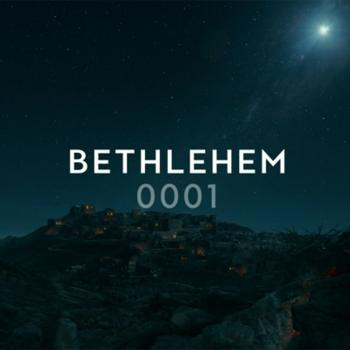There are many books about the early chapters of Genesis, and many books introducing readers to the scientific understanding of the cosmos and our place in it. But there are few which actually try to combine the two aims into one. Karl Giberson’s book, Seven Glorious Days: A Scientist Retells the Genesis Creation Story
, and I am grateful to have the opportunity to participate in the Patheos Book Club discussion of this book.
The book opens with a brief presentation of major stages in the history of the cosmos, broken up into seven epochs or days. After that, the introduction provides a brief overview of the epochs in Giberson’s own life exploring the intersection of religion and science – his upbringing in a fairly literalistic form of Christianity, his adoption of young-earth creationism, his discovery while studying at a Christian university that what science has to say is in fact right, and much else, leading ultimately to a career dedicated to teaching science to Christian college students. It was this that led him to reflect on what it might mean to “update” the Genesis account of creation. On the one hand, reflecting ancient cosmological ideas and language, Genesis seems “tarnished” to those who read it today. Yet the portrait offered by science can seem to have nothing to say specifically to people of faith. And so in this book, Giberson tries to offer an overview of how science understands our history and origins, told in a manner that mediates that story specifically to people of Christian faith.
Giberson emphasizes a few points to avoid misunderstandings, which I think I should therefore be sure to mention here in this review. Giberson is not trying to rewrite Genesis with the aim of then discarding that text in favor of what he has produced. His point in doing this is that “The more we tie God’s creative work to the ancient worldview in Genesis, the less likely people are to take the idea of a creator God seriously” (p.4). And so Giberson is best viewed as doing what the author of Genesis did long ago – viewing the current understanding of the nature of and processes at work in the cosmos as the handiwork of God. Giberson also emphasizes that he is not engaging in the “day-age” approach that attempts to shoehorn modern science into Genesis. His division of his account into seven epochs is stylistic – as, one could argue, is the account in Genesis – and does not reflect something inherent in the scientific understanding of the history of the universe (pp.5-6).
Giberson proceeds to give yet another overview of the seven epochs the rest of the book will discuss in detail, before turning to each of them in separate chapters.
The story of the cosmos, like the story in Genesis, begins at a somewhat arbitrary “beginning” – one that clearly presupposes order and a framework which already existed prior to that point. The story of the cosmos, Giberson emphasizes early on, is a breathtakingly beautiful one – but it is also a story that scientists sometimes fail to tell as well as poets can. Giberson uses many analogies, such as comparing the four fundamental forces to “four horsemen of creation” or talking about fundamental building blocks of matter as like “LEGOs.”
Giberson also uses Biblical metaphors, some of which work wonderfully – and others of which I am less sure about (see e.g. p.71).
Since there are many introductions to the scientific view of human beings and of our cosmic context, an appropriate question to ask is what, if anything, Giberson’s treatment of the subject offers that others do not. At moments in the book, one might indeed wonder whether this “updating” of Genesis is not in fact merely yet another telling of science’s story. But at key moments, the distinctive focus becomes clear – and it is arguable that in those moments when there is no distinctively Biblical or religious slant, there is little that a religious believer could or ought to say about that topic other than what science has to offer.
The distinctive angle on the subject matter has to do with significance – and once again it might be said that where Genesis differs from other ancient creation stories from the Ancient Near East is not about material substances or cosmic processes but significance as well. And so this being what sets Giberson’s telling of the scientific story apart seems deeply appropriate.
On pp.78-79, Giberson explicitly raises the issue, which he then returns to again and again through the remainder of the book: Does science teach that we are insignificant or significant? He helpfully discusses scientists’ depiction of our world as but a speck, a “pale blue dot” in a vast universe. But he argues (pp.109-111) that size is only one way of assessing significance, and almost certainly not the most important. If we view our place in the cosmos in other terms, such as information and/or cognition, the picture changes. Giberson explores this point by verbally describing what the picture would look like if information – things like language, science, math, and other human thoughts and communications, which can often exist in quite small spaces – were represented by corresponding size. “If all this information took up space, then the earth would be bigger than the sun. It would be larger than the entire solar system. It would be larger than our galaxy” (pp.110-111). And so Giberson argues that our significance should not be evaluated in terms of our size in a vast cosmos. If we are the only world with life, and Earth the only place where sentient beings ponder deep mysteries, then we are perhaps the most significant things in the cosmos, the sole instance of the universe coming to reflect on its own existence.
Giberson responds not only to those who try to make arguments against our significance based on science, but also to those who argue against science based on dubious claims and reasoning. He focuses particular attention on Ken Ham’s question (quoted on p.116) as to why the Creator would use a process that involves “animals…ripping each other up over millions of years.” Giberson responds by noting that this caricature of the history of life is extremely dubious. If we think of two human beings, one of whom has two children and the other none, there is an evolutionary success by one and failure by the other – but no ripping of one another apart. The argument that violence typifies life on our planet is as problematic as the argument that it typifies human existence in the present. We may highlight such acts in reporting the news, but the truth is that we go about our daily lives without experiencing it as often as such reports might lead one to expect. Giberson then goes on to provide illustrations of cooperation and even kindness in the natural world.
The final section of the book focuses on love, as representing something that has emerged in the natural order, and which represents an area in which the natural sciences, once skeptical that kissing and touching could do anything but transmit germs in a dangerous manner, came around to what bearers of religious insights had emphasized all along – love and affection are crucially important, and not optional extras, when it comes to human existence.
If at times there have seemed to be threads of purposeless acts of “Nature” and threads of purposefulness in Giberson’s description of the cosmos and the history of life on our planet, in the end, they are woven together. He talks about divine action, and while emphasizing that there is no place for discussion of divine purpose in a science textbook, that does not mean that the universe as we know it is closed to that possibility, nor that we, beholding a cosmos that has brought us into existence, cannot reasonably believe that through the processes that sciences study and help us to understand, activity of a Creator was finding expression. Giberson concludes on the last few pages with thoughts from a specifically Christian perspective. But throughout most of the book, what is being said could be appreciated by most religious believers, as indeed much of it could be appreciated by anyone interested in science.
I believe that Karl Giberson’s book, taken as a whole, accomplishes what he set out to. It offers a telling of science’s story which views that story much as the author of Genesis viewed the cosmos as understood in his time: as an expression of the will of a Creator. While young-earth creationists actually undermine acceptance of such a belief by focusing the attention of people on the ancient understanding of the natural world reflected in Genesis, and others as a result find it easy to dismiss both together, Giberson offers an updating of the science with a reiteration of the central point of Genesis. I can only hope that increasing numbers of Christians will turn to Giberson’s book and come to share his appreciation for the story that science has revealed. If so, perhaps some of the harm caused to the Christian faith, and the perception of it by others, brought about by people like Ken Ham and other young-earth creationists, can at last be undone. I give this book an enthusiastic recommendation.














